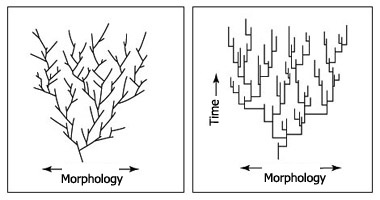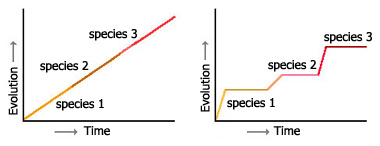Tool Module: Gradual Evolution
or Punctuated Equilibria?
Another important question about evolution,
in addition to what mechanisms lead to the formation of new species, is how these
mechanisms operate over time.
Darwin had shown several examples of evolution
where certain anatomical traits were transformed gradually, giving rise to new
species. According to this gradualist conception of evolution,
new species arise through the gradual transformation of ancestral species, and
these slow, regular transformations involve the entire population of a species
across its entire range.
But Darwin never excluded the possibility that
other transformations may have followed a different dynamic. One very different
alternative was proposed in the early 1970s by Steven Jay Gould and Nils Eldredge:
that evolution might proceed in a non-continuous manner, with long periods of
stagnation interrupted by short, sudden periods of rapid transformation leading
to the formation of new species.
This theory of punctuated equilibria
could account for many paleontological observations . It could explain
why the fossil record contains some species that showed very little morphological
variation over their entire existence, even though they were around for several
million years. It could also explain why this record often shows such species
being supplanted suddenly (over a few tens of thousands of years) by a new, clearly
differentiated species. And most important, this theory could explain why no fossils
of transitional forms between these species may be found: the small size of the
intermediate populations, which did not have enough time to leave fossil traces,
because the conditions required for fossilization are so rare.
There
are a number of species whose evolution seems to have followed this dynamic of
punctuated equilibria. But there is still significant debate in the scientific
community about the relative importance of punctuated equilibria and gradualism
(of which there are also some convincing examples). Are these two dynamics of
equal importance, or is one the exception and the other the rule? This question
has stimulated a number of studies now in progress. Further studies will be needed
to try to determine what factors trigger periods of rapid transformation and what
factors encourage long periods of stability.
 |
 |
Two ways of representing evolution by gradualism versus evolution by punctuated equilibria. In the case of gradualism (left), the diagonal lines indicate that morphological changes occur bit by bit over time. In the case of punctuated equilibria (right), the step-like patterns represent rapid morphological changes followed by long periods when the species evolves very little.
